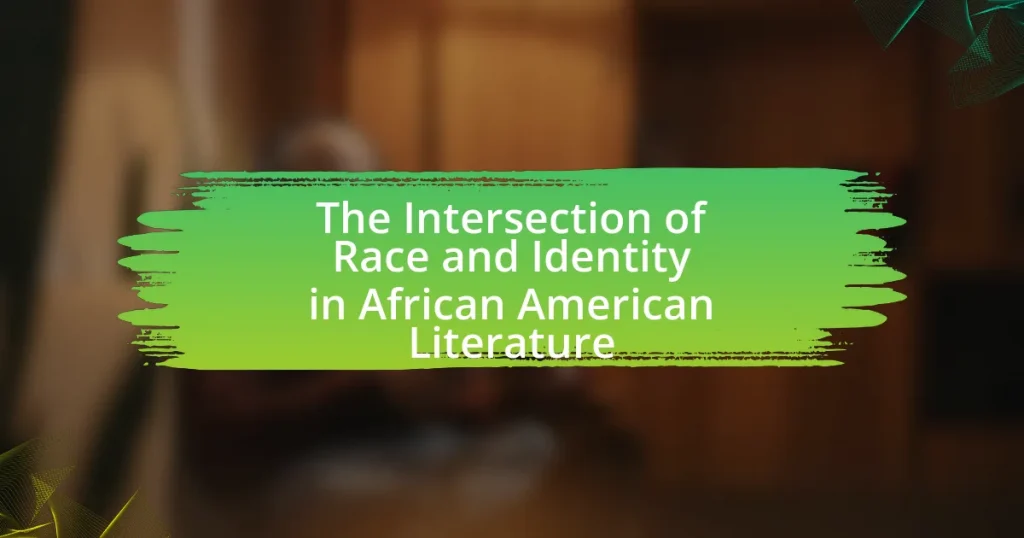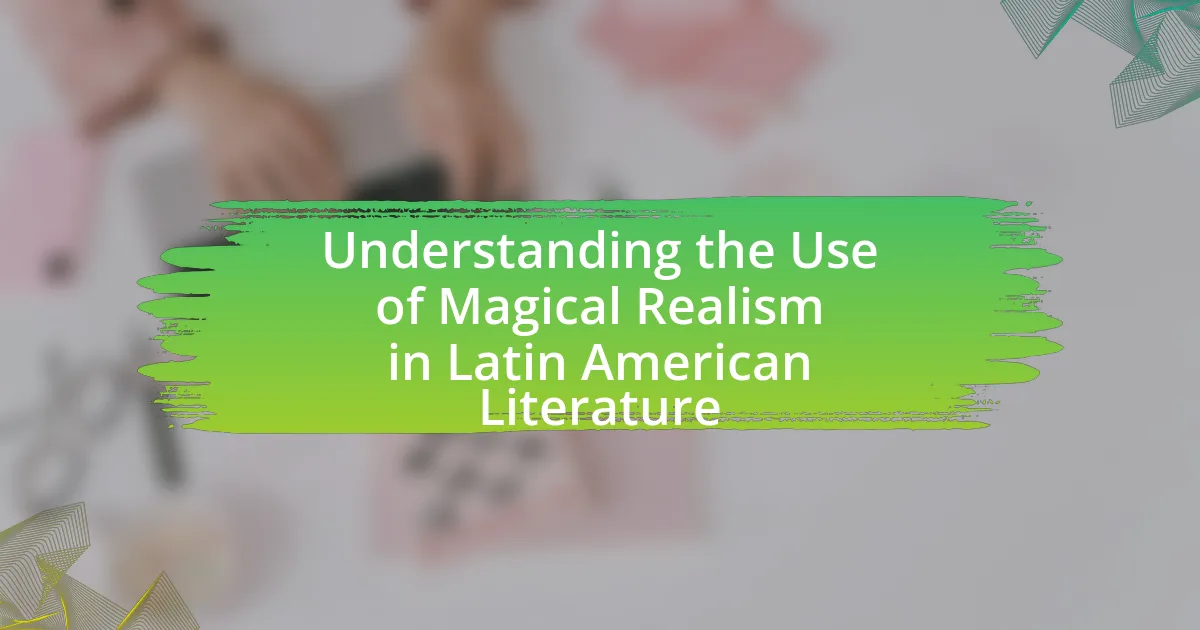The article examines the intersection of race and identity in African American literature, highlighting how racial experiences shape both individual and collective identities within the African American community. It discusses key themes such as oppression, resilience, and the quest for self-definition, as illustrated in notable works by authors like W.E.B. Du Bois, Zora Neale Hurston, and Toni Morrison. The article also explores the historical context of slavery and segregation, the impact of literary movements like the Harlem Renaissance, and the ongoing relevance of these themes in contemporary literature, emphasizing the importance of understanding race and identity in literary studies and broader societal discussions.
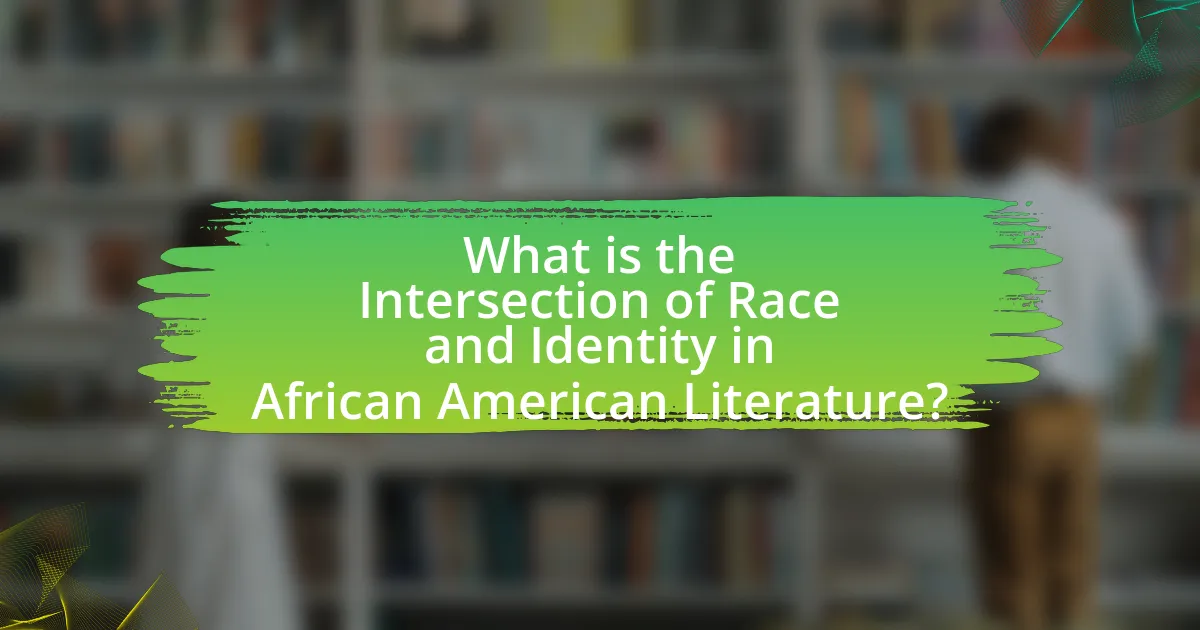
What is the Intersection of Race and Identity in African American Literature?
The intersection of race and identity in African American literature explores how racial experiences shape individual and collective identities within the African American community. This literature often reflects the historical context of slavery, segregation, and systemic racism, which profoundly influence the characters’ identities and their struggles for self-definition. For instance, works like “The Souls of Black Folk” by W.E.B. Du Bois articulate the concept of double consciousness, where African Americans navigate their identity through the lens of both their own self-perception and the perceptions imposed by a racially biased society. This duality highlights the complexities of identity formation in a racially stratified context, demonstrating that race is not merely a social construct but a fundamental aspect of personal and cultural identity in African American literature.
How does race influence identity in African American literary works?
Race significantly influences identity in African American literary works by shaping characters’ experiences, perspectives, and cultural expressions. This influence is evident in the exploration of themes such as oppression, resilience, and the quest for self-definition amidst societal constraints. For instance, in works like “Their Eyes Were Watching God” by Zora Neale Hurston, the protagonist Janie’s journey reflects the complexities of race and gender, illustrating how these intersect to form her identity. Additionally, the historical context of slavery and segregation informs narratives, as seen in “The Narrative of the Life of Frederick Douglass,” where Douglass articulates the struggle for identity against the backdrop of racial dehumanization. These literary examples demonstrate that race is not merely a backdrop but a central element that shapes the identities and narratives within African American literature.
What themes emerge from the exploration of race in these texts?
The exploration of race in these texts reveals themes of identity, systemic oppression, and resilience. Identity is often portrayed as multifaceted, shaped by both personal experiences and societal perceptions, highlighting the struggle for self-definition amidst external racial stereotypes. Systemic oppression is depicted through historical and contemporary injustices, illustrating how institutional racism affects the lives of African Americans. Resilience emerges as a central theme, showcasing the strength and determination of individuals and communities to overcome adversity and assert their dignity. These themes are supported by narratives that reflect real historical contexts, such as the impact of slavery, segregation, and ongoing discrimination, which collectively inform the African American experience.
How do authors portray the complexities of identity in relation to race?
Authors portray the complexities of identity in relation to race by exploring the multifaceted experiences of individuals within racial contexts. For instance, in works like “The Souls of Black Folk” by W.E.B. Du Bois, the concept of “double consciousness” illustrates the internal conflict faced by African Americans as they navigate their identity in a society that marginalizes them. This duality highlights the struggle between self-perception and societal perception, emphasizing how race shapes personal and collective identity. Additionally, in “Beloved” by Toni Morrison, the haunting legacy of slavery complicates identity, as characters grapple with their past and its impact on their present selves. These narratives demonstrate that identity is not a singular or static concept but is deeply influenced by historical, cultural, and social factors related to race.
Why is understanding this intersection important in literary studies?
Understanding the intersection of race and identity is crucial in literary studies because it reveals how African American literature reflects and shapes cultural narratives. This intersection allows scholars to analyze the complexities of identity formation within the context of systemic racism and social constructs. For instance, works by authors like Toni Morrison and James Baldwin illustrate how personal and collective identities are influenced by historical and social factors, providing insight into the lived experiences of African Americans. Such analysis is supported by critical frameworks that emphasize the importance of race in shaping literary themes, character development, and narrative structure, thereby enriching the understanding of both literature and society.
How does it contribute to broader discussions of race and identity in society?
African American literature significantly contributes to broader discussions of race and identity in society by providing a platform for the exploration of the complexities of racial experiences and cultural identity. This literary genre often reflects the historical struggles, resilience, and diverse narratives of African Americans, which fosters a deeper understanding of systemic racism and identity formation. For instance, works like “Their Eyes Were Watching God” by Zora Neale Hurston and “The Souls of Black Folk” by W.E.B. Du Bois illustrate the intersectionality of race, gender, and class, highlighting how these factors shape individual and collective identities. Such literature not only documents personal and communal histories but also challenges prevailing stereotypes and encourages critical dialogue about race relations, identity politics, and social justice in contemporary society.
What role does historical context play in shaping these narratives?
Historical context significantly influences the narratives within African American literature by providing a framework through which authors express their experiences and identities. The historical backdrop of slavery, segregation, and civil rights movements shapes the themes, characters, and plots in these works, reflecting the struggles and resilience of African Americans. For instance, the impact of the Jim Crow laws and the Great Migration is evident in the writings of authors like Zora Neale Hurston and Richard Wright, who depict the complexities of race and identity in their narratives. This context not only informs the characters’ motivations and conflicts but also serves as a critique of societal norms, illustrating how historical events have shaped the collective consciousness of African American communities.
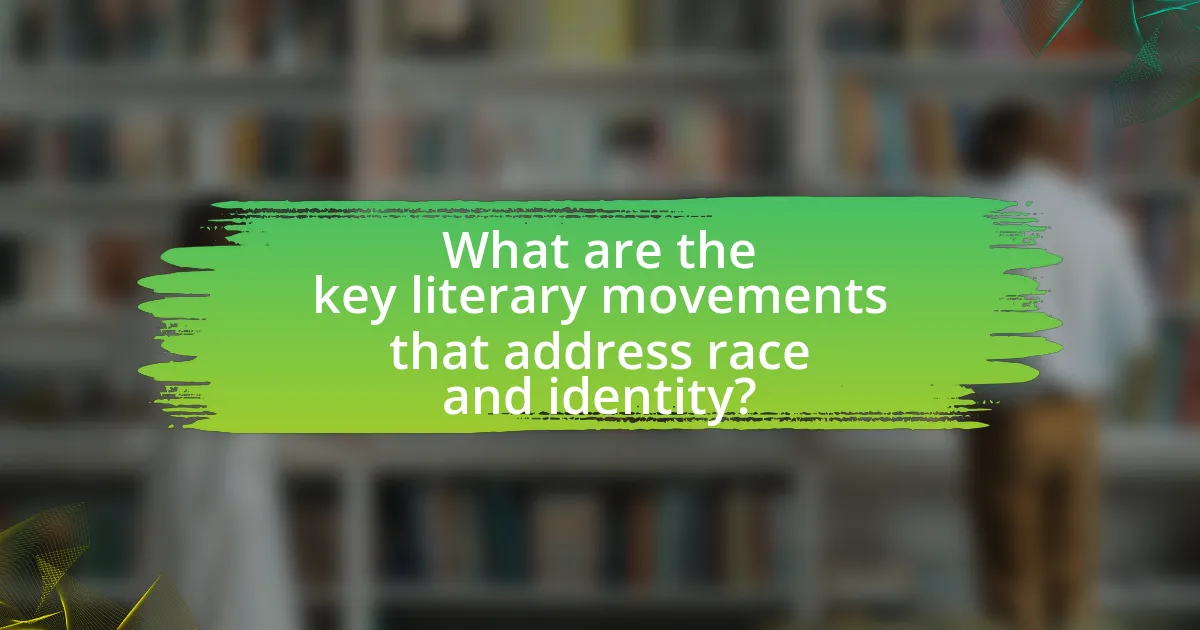
What are the key literary movements that address race and identity?
Key literary movements that address race and identity include the Harlem Renaissance, the Black Arts Movement, and contemporary Afrocentric literature. The Harlem Renaissance, which flourished in the 1920s, celebrated African American culture and produced influential works by writers such as Langston Hughes and Zora Neale Hurston, emphasizing racial pride and identity. The Black Arts Movement of the 1960s and 1970s sought to create a distinct African American aesthetic and was characterized by works that addressed social issues, with figures like Amiri Baraka and Nikki Giovanni at the forefront. Contemporary Afrocentric literature continues to explore themes of race and identity, often incorporating diverse perspectives and experiences, as seen in the works of authors like Chimamanda Ngozi Adichie and Ta-Nehisi Coates. These movements collectively highlight the complexities of race and identity within the African American experience.
How did the Harlem Renaissance shape African American literature?
The Harlem Renaissance significantly shaped African American literature by fostering a cultural and artistic explosion that emphasized racial pride and identity. This movement, which spanned the 1920s, encouraged African American writers to explore themes of race, heritage, and social justice, leading to the emergence of influential figures such as Langston Hughes, Zora Neale Hurston, and Claude McKay. Their works often challenged prevailing stereotypes and depicted the complexities of African American life, contributing to a richer, more nuanced literary tradition. The period also saw the establishment of literary journals and organizations that promoted African American voices, further solidifying the importance of this era in shaping the trajectory of African American literature.
What were the defining characteristics of this movement?
The defining characteristics of the movement focused on the intersection of race and identity in African American literature include a profound exploration of racial identity, cultural heritage, and social justice. This movement emphasizes the significance of personal and collective experiences shaped by systemic racism and historical oppression. Notable works often reflect themes of resilience, identity formation, and the quest for equality, as seen in the writings of authors like Zora Neale Hurston and James Baldwin. Their literature serves as a vehicle for articulating the complexities of African American life, illustrating the struggle against marginalization while celebrating cultural richness.
Who were the prominent figures, and what were their contributions?
Prominent figures in the intersection of race and identity in African American literature include Langston Hughes, Zora Neale Hurston, and James Baldwin. Langston Hughes contributed significantly through his poetry and essays that celebrated African American culture and addressed racial issues, exemplified in works like “The Weary Blues.” Zora Neale Hurston’s novel “Their Eyes Were Watching God” explored the complexities of African American womanhood and identity, emphasizing personal voice and cultural heritage. James Baldwin’s essays and novels, such as “Go Tell It on the Mountain,” examined the intricacies of race, sexuality, and identity in America, influencing both literature and social thought. These authors shaped the discourse on race and identity, providing profound insights into the African American experience.
What impact did the Civil Rights Movement have on literature?
The Civil Rights Movement significantly transformed literature by amplifying African American voices and themes of racial identity, justice, and resistance. This period saw the emergence of powerful literary works that addressed social injustices, such as James Baldwin’s “The Fire Next Time” and Maya Angelou’s “I Know Why the Caged Bird Sings,” which explored personal and collective experiences of racism and resilience. The movement inspired writers to confront systemic oppression and articulate the struggles for equality, leading to a rich body of literature that not only documented the era’s challenges but also celebrated cultural identity and heritage. This literary output contributed to a broader understanding of race relations in America and influenced subsequent generations of writers.
How did authors respond to the social changes of the era?
Authors responded to the social changes of the era by reflecting the complexities of race and identity in their works. For instance, during the Harlem Renaissance, writers like Langston Hughes and Zora Neale Hurston explored themes of racial pride and cultural identity, addressing the struggles and aspirations of African Americans in a society marked by systemic racism. Their literature often served as a form of resistance, challenging prevailing stereotypes and advocating for social justice. This response was evident in Hughes’ poem “The Negro Speaks of Rivers,” which connects African American identity to a broader historical narrative, emphasizing resilience and cultural heritage. Such literary contributions not only documented the social realities of their time but also inspired future generations to engage with issues of race and identity.
What themes of resistance and empowerment emerged in this literature?
Themes of resistance and empowerment in African American literature prominently include the struggle against systemic oppression and the assertion of identity. Literature such as “Their Eyes Were Watching God” by Zora Neale Hurston illustrates the protagonist’s journey toward self-discovery and independence, symbolizing personal empowerment against societal constraints. Additionally, works like “The Souls of Black Folk” by W.E.B. Du Bois emphasize the importance of cultural heritage and collective resistance to racial injustice, showcasing the resilience of the African American community. These themes are validated by historical contexts, such as the Civil Rights Movement, which inspired many authors to articulate their experiences and advocate for social change through their narratives.
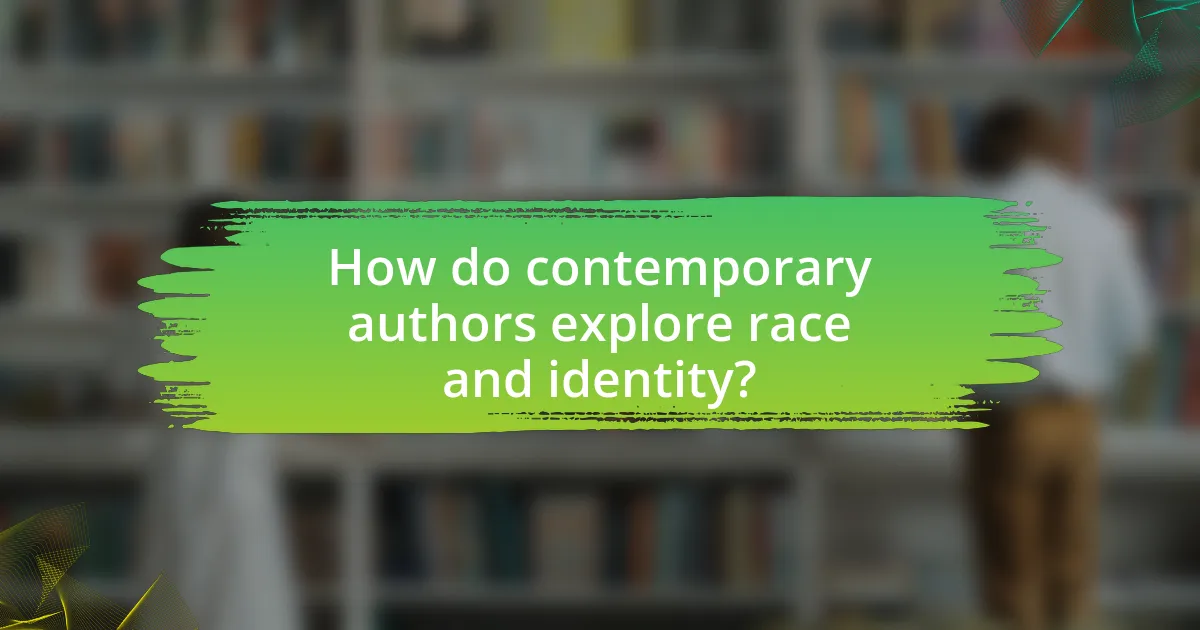
How do contemporary authors explore race and identity?
Contemporary authors explore race and identity by delving into personal narratives that reflect the complexities of cultural heritage and societal perceptions. They often utilize character-driven stories to illustrate the impact of systemic racism and the quest for self-identity within diverse communities. For instance, authors like Chimamanda Ngozi Adichie in “Americanah” examine the nuances of race through the lens of immigration and cultural dislocation, highlighting how identity is shaped by both personal experiences and societal expectations. Additionally, Ta-Nehisi Coates in “Between the World and Me” presents a poignant exploration of race in America, articulating the lived experiences of Black individuals in a racially stratified society. These works underscore the intersectionality of race and identity, demonstrating how contemporary literature serves as a platform for dialogue and understanding regarding these critical issues.
What are the prevalent themes in modern African American literature?
Prevalent themes in modern African American literature include identity, race, resilience, and social justice. These themes reflect the complexities of African American experiences and the ongoing struggle against systemic racism. For instance, works by authors like Ta-Nehisi Coates in “Between the World and Me” explore personal and collective identity in the context of historical and contemporary racial issues. Additionally, themes of resilience are evident in narratives that highlight the strength and perseverance of African Americans in the face of adversity, as seen in novels like “The Underground Railroad” by Colson Whitehead, which reimagines the historical journey to freedom. Social justice is a recurring theme, with literature often serving as a platform for activism and advocacy, as demonstrated in the poetry of Amanda Gorman, who addresses societal inequities and calls for change. These themes collectively illustrate the rich tapestry of modern African American literature, emphasizing the intersection of race and identity.
How do current authors address intersectionality in their works?
Current authors address intersectionality in their works by exploring the interconnectedness of race, gender, sexuality, and class within their narratives. For instance, writers like Jesmyn Ward and Claudia Rankine incorporate personal and collective experiences that highlight how these identities shape the lived realities of African Americans. Their works often reflect on systemic inequalities and the complexities of identity, demonstrating how multiple social categories intersect to influence individual experiences. This approach is evident in Rankine’s “Citizen: An American Lyric,” which examines racial microaggressions alongside themes of gender and class, illustrating the multifaceted nature of identity in contemporary society.
What new perspectives on race and identity are being introduced?
New perspectives on race and identity being introduced in African American literature emphasize the fluidity of identity and the intersectionality of race with other social categories such as gender, class, and sexuality. This shift is evident in contemporary works that challenge monolithic representations of Black identity, showcasing diverse experiences and narratives. For example, authors like Claudia Rankine in “Citizen: An American Lyric” explore the complexities of racial microaggressions and their impact on personal identity, illustrating how race interacts with everyday life. Additionally, the rise of Afro-futurism in literature reimagines Black identity through speculative narratives, allowing for a redefinition of race that transcends historical oppression and envisions new possibilities. These perspectives reflect a broader understanding of identity as multifaceted and dynamic, moving beyond traditional frameworks.
How can readers engage with these themes in their own lives?
Readers can engage with the themes of race and identity in African American literature by reflecting on their own experiences and understanding the historical context of these narratives. By actively participating in discussions about race, readers can draw parallels between the struggles depicted in literature and contemporary societal issues, fostering empathy and awareness. Engaging with community events, book clubs, or educational programs focused on African American literature can further enhance this understanding, as studies show that literature can significantly influence one’s perspective on social issues (National Endowment for the Arts, 2017). This engagement not only deepens personal insight but also promotes a broader dialogue about race and identity in society.
What are some recommended readings that illustrate these concepts?
Recommended readings that illustrate the intersection of race and identity in African American literature include “The Souls of Black Folk” by W.E.B. Du Bois, which explores the duality of African American identity and the concept of “double consciousness.” Another significant work is “Their Eyes Were Watching God” by Zora Neale Hurston, which delves into the complexities of race and gender identity through the life of an African American woman. Additionally, “Beloved” by Toni Morrison addresses the haunting legacy of slavery and its impact on identity. These texts provide critical insights into the nuanced relationship between race and identity within the African American experience.
How can discussions about race and identity in literature foster understanding and empathy?
Discussions about race and identity in literature foster understanding and empathy by providing readers with diverse perspectives that challenge their own viewpoints. Literature often portrays the lived experiences of marginalized groups, allowing readers to engage with narratives that reflect the complexities of race and identity. For instance, novels like “The Color Purple” by Alice Walker and “Between the World and Me” by Ta-Nehisi Coates illustrate the struggles and triumphs of African American individuals, enabling readers to connect emotionally with characters and their journeys. This emotional connection can lead to greater awareness of systemic issues and personal biases, ultimately promoting empathy and a deeper understanding of different cultural experiences.
